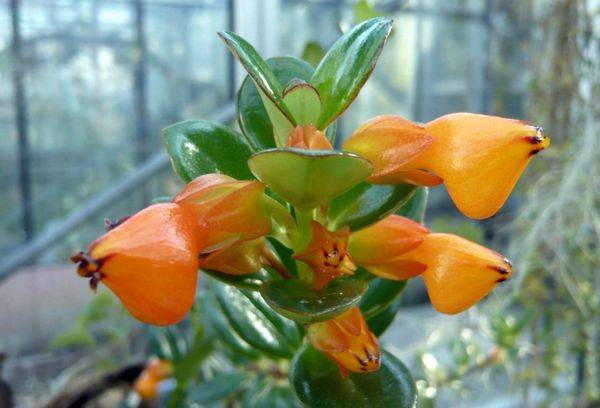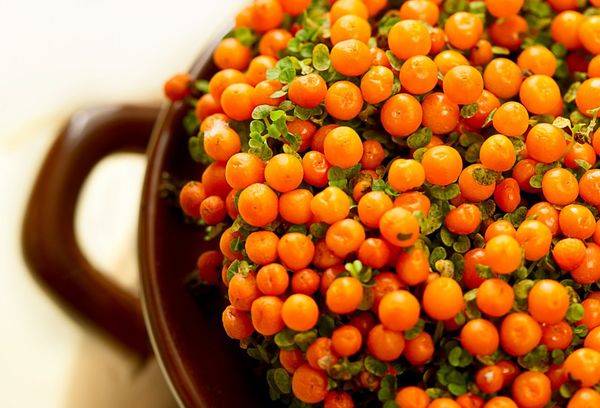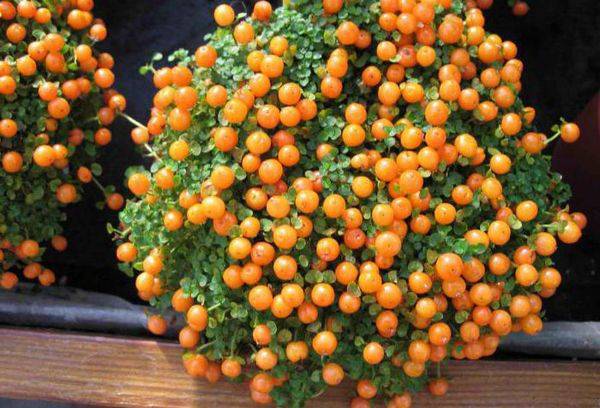Nerter's house - how to properly care for a guest from the tropics
In wildlife, Nertera is found in tropical areas: Africa and Asia, New Zealand and South America, Australia and Mexico. It belongs to the madder family. The plant is fully adapted to wet and hot environments. Nertera is a creeping herbaceous perennial with fine and shiny rounded foliage. Budding occurs in the spring, by autumn, round fruits ripen. Single flowers are small and unexpressive, painted mainly in pale colors.
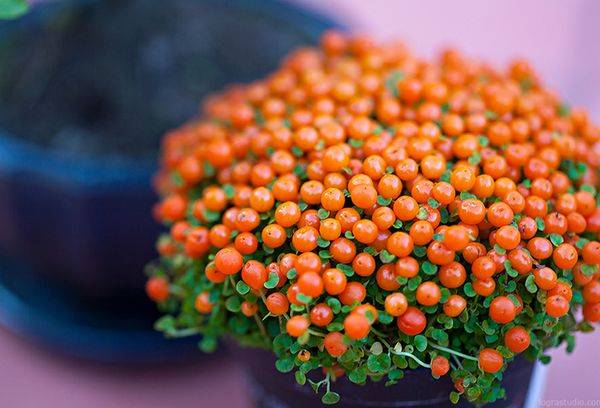
Nertera Grand
Tip
Nerter usually buy for one season. After ripening berries, it grows and loses decorative qualities. Compliance with the recommendations for care makes it possible to extend the life of the flower, so that the nerter will bear fruit for several years in a row.
The genus of Nerter includes only 12 species, plants develop well at home and in greenhouses, in summer they feel great outdoors. The main feature and decoration of the flower is a large number of spectacular orange-red berries. The stems of the plant spread along the ground, rising in height by only 2-3 cm. The foliage is small with a smooth surface, in texture - dense. The shape of the leaves varies from rounded to slightly elongated.
Important
The fruits of Nerter are unsuitable for food, as they are poisonous.
Varieties
Experts say that culture is endowed with powerful positive energy, its presence in the house improves the mood of people and unites them among themselves.
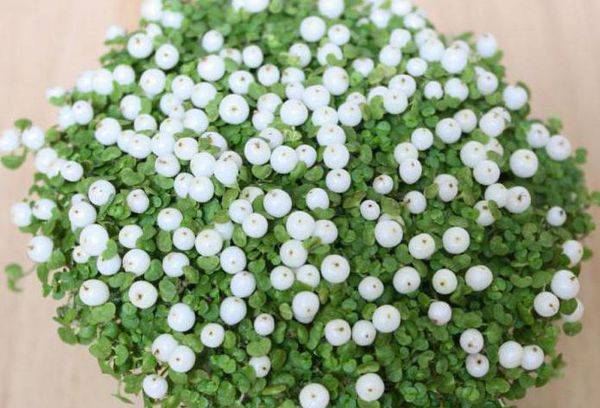
Nertera Grandesis Mix
Among a small number of representatives in home floriculture, the following species are cultivated:
- Pressed nerter. This species has glossy green leaves of a rounded shape, reaching a diameter of 0.5-0.6 cm. The plant forms dense pillows. After flowering, reddish-orange fruits in the form of oblong berries are tied on it, which do not fall for several months.
- Black berry nerter. A distinctive feature of this species is the fruit of black color. The homeland of this species is America, its central and southern parts.
- Granadensis. This nerter has small lanceolate leaves sitting on short petioles. In length, leaf plates reach 5-7 mm. In early summer, single greenish-white flowers form on the plant, which by autumn turn into numerous orange berries. The fruits persist until the end of autumn, sometimes hold throughout the winter.
- Astrid. This species is native to Mexico. It is a hybrid of nerter granadensis, which differs from it by a particularly large number of fruits in the form of round orange berries.
- Balfura. This representative has pear-shaped fruits, which are formed much less than in other species. Habitat of Nerter Balfur is a wetland of New Zealand.
- Nerter Cunningham grows with miniature bushes strewn with small red berries.
- Nertera ciliated. Its stem and leaves are covered with small light, relatively long hairs. Fruits are rounded and have a rich red tint.
Care and maintenance rules
Growing conditions. High humidity is the key to the beauty of a flower all year round. Pots with room seals are placed on trays with wet expanded clay or sphagnum. The procedure allows you to increase air humidity, which means to bring the conditions closer to the usual for this plant.
Lighting. The tropical environment of origin endowed this plant with the habit of living in well-lit places. At the same time, direct sunlight should not be allowed on leaves and stems.In the morning and evening hours, it is desirable that a shadow fall on the flower and it rests from the sun.
Watering mode. A plant from the tropics is accustomed to moisture and precipitation, so watering seals should be regular and plentiful. One of the important care measures is spraying. It is carried out before flowering, during the period of active growth and development of the flower. Do not spray buds or berries.
Fertilizers Nerter feeding is carried out regularly - once every 2-3 weeks. For this, mineral fertilizers for home flowers in half dosage are suitable, occasionally it is allowed to make nitrogen top dressing.
Transfer. The plant should be relocated in early spring, before flowering begins. Suitable soil is loose and water-intensive, for example, sand and garden soil mixed in equal parts. Drainage at the bottom of the pot is required. Regular cultivation of the earth is recommended to improve respiration of the root system.
Reproduction. The culture is settled in 2 ways - by dividing the bush and mature seeds, the second way is longer and less reliable. Seeds are sown in a substrate of peat and flower soil, the surface is systematically moistened. A container with planted seeds is covered with glass and kept at room temperature.
Tip
The magazine purityis.decorexpro.com/en/ notes that Nerter Astrid loves to grow in the sun, so in the autumn-winter season it is recommended to make artificial lighting for it.
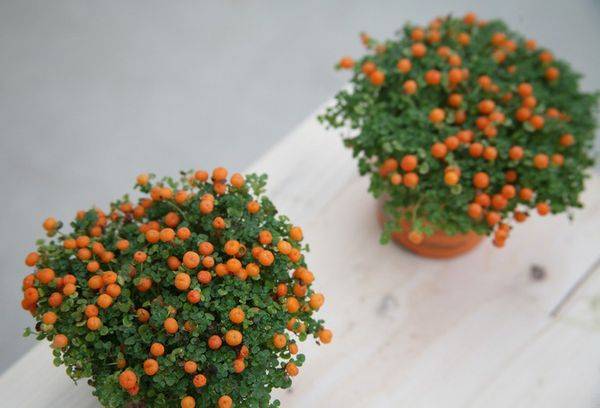
Nerter's “coral moss”
For planting in another way, the rhizome of Nerter, after the fruit has fallen, is divided into parts and planted in different pots. A good base for a new flower is a mixture of turf and garden soil, a little humus, interspersed with coarse sand and peat. For good rooting, a layer of good drainage is required. A pot for nerter is best to choose wide and shallow.
Growing problems
The optimum temperature regime is from +20 to + 25 ° C. Too hot or cold conditions damage the flower - it becomes weak and lifeless, loses its fruits and refuses to bloom in the future. Although Nerter is used to heavy watering, excess moisture destroys it.
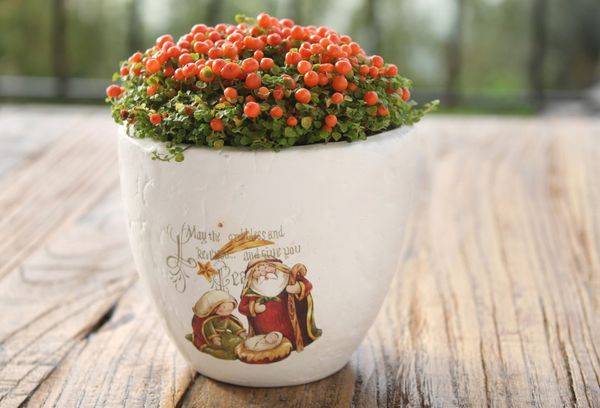
Nertera Pressed
A few more subtleties that must be considered:
- in a hot environment nerter grows green mass and does not bloom;
- excessive moisture in the soil and air leads to rotting of rhizomes and stems;
- the bright sun often burns the flower, which is manifested by drying of the ends of leaves and berries;
- excessive spraying provokes yellowness on the foliage and its fall;
- shriveled fruits are the result of the high temperature of the flower;
- the whitefly, scutellum, spider mite and mealybug parasitize on the nerter.
Due to the abundance of reddish fruits in the people, this perennial plant is called "coral moss." The combination of dense green foliage and unusual round fruits makes an unforgettable impression. A colorful and compact nerter will decorate the windowsill in any room, bring joy at work and will become the highlight of the home garden.
